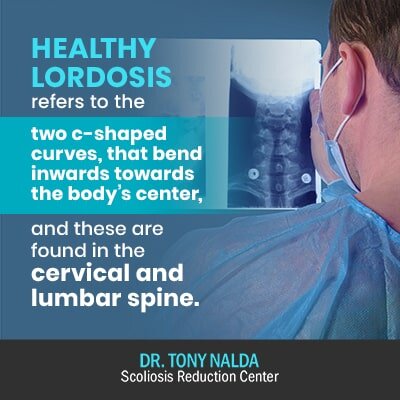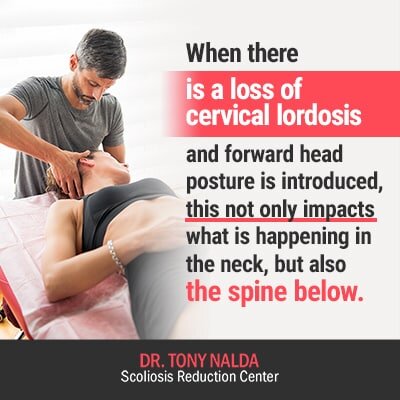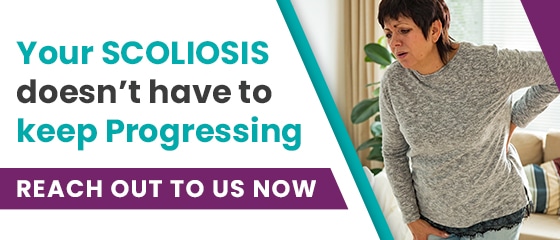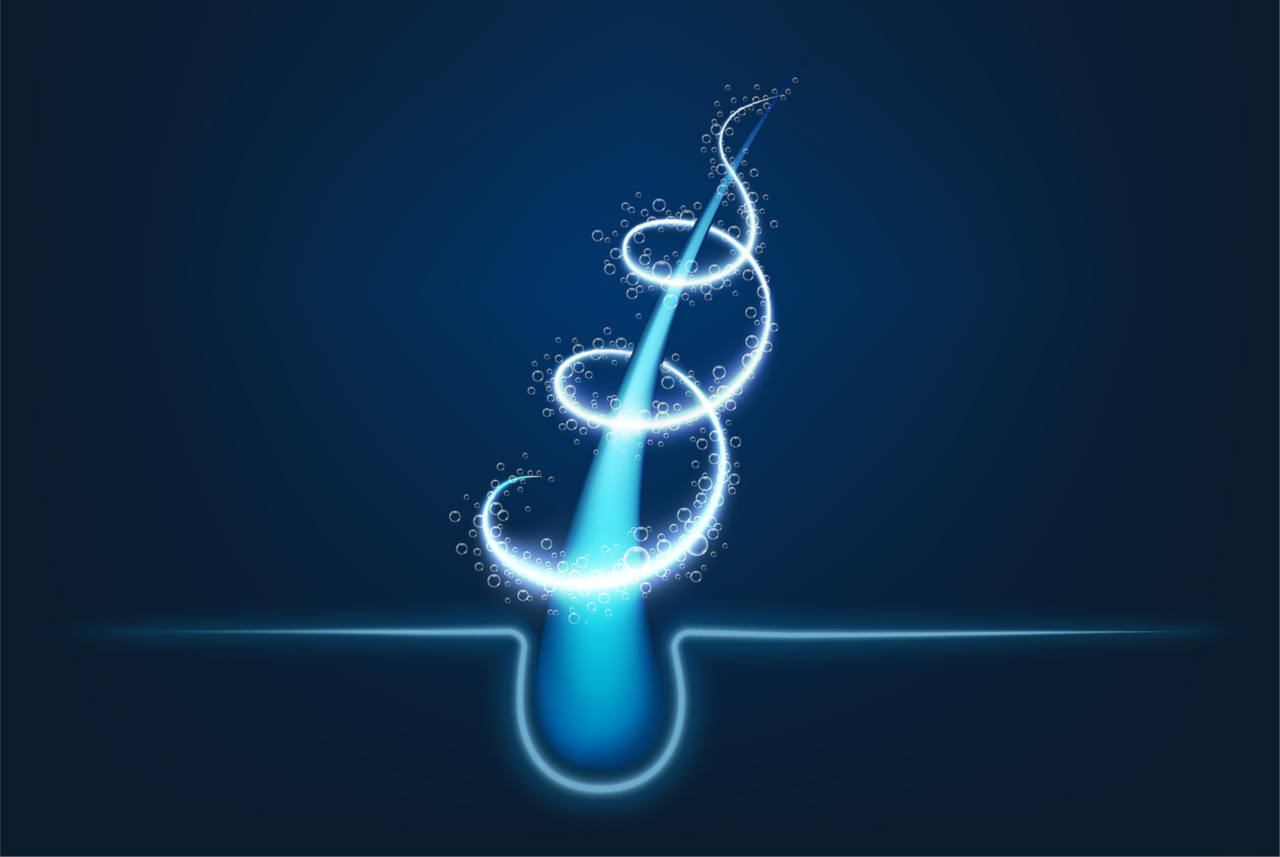The spine consists of three main natural and healthy curves, and these curves give it its strength and flexibility. A loss of these curves can result in a number of issues that can be felt throughout the body. A healthy ‘cervical lordosis’ refers to the natural curvature of the cervical spine. When there is a loss of cervical lordosis, the neck can become abnormally straight, increasing the chances of developing what’s known as ‘forward head posture’ and adverse spinal tension that impacts the entire spine.
Before we proceed with defining cervical lordosis, I would like to first introduce some basic spinal anatomy and terminology that will be used throughout this article to ensure clarity and understanding.
Basic Spinal Anatomy
As mentioned, the spine is curved for a reason: to make it as strong and flexible as possible. The spine does a lot for us. It protects the spinal cord, which works in tandem with the brain to form the central nervous system, and many of the body’s internal organs. It also provides the body with essential structural support, allowing us to maintain balance and upright posture.
The spine is divided into three main sections: cervical, thoracic, and lumbar. The cervical spine includes the neck and connects to the upper back at the shoulder level; the thoracic spine refers to the upper and middle back, and the lumbar spine refers to the lower back.
There is also a smaller section known as the sacral spine, which refers to where the lumbar spine meets the sacrum, forming the hip bones and pelvis. The sacrum and coccyx (commonly known as the tailbone) add a soft curve at the spine’s base.
Each of the above sections has a characteristic curve. These are evident if you look at the human spine from the side. The soft ‘S’ shape consists of three main healthy curves that move inwards towards the body’s center and outwards away from it.
Cervical Lordosis & What Causes Loss of Cervical Lordosis
Vertebrae and Spinal Discs
The spinal column is made up of individual bones called vertebrae, and there are 33 in total. Each bony vertebra is separated by a spinal disc that has three main functions: to act as the spine’s shock absorbers, tough ligaments that connect the spine’s vertebrae, and cartilaginous joints that facilitate the spine’s mobility.
It’s important to understand the role of the spinal discs as conditions of the spine, such as a loss of cervical lordosis, can impact their health and function.
Lordosis and Kyphosis

Healthy lordosis refers to the two c-shaped curves that bend inwards towards the body’s center, and these are found in the cervical and lumbar spine. Healthy kyphosis refers to the natural reverse c-shaped curve that characterizes the thoracic spine.
When these natural and healthy spinal curves are present, they help the spine to act as a coiled spring, distributing weight and impact evenly throughout.
In light of the many crucial roles that the spine plays in facilitating communication between the brain and the rest of the body, protecting internal organs, maintaining balance, posture, and movement, you can see how a loss of even one of these curves can affect multiple areas and systems within the body.
Defining Cervical Lordosis and Loss of Cervical Lordosis
Now that we have clearly defined and discussed the spine, its sections, curves, where those curves are located, and the role of spinal discs, we can move on to defining cervical lordosis and loss of cervical lordosis.
As mentioned, healthy cervical lordosis refers to the natural c-shaped inward curve that characterizes the upper back and neck.
When the spine in the neck region doesn’t have the healthy curve that it should, this is a loss of cervical lordosis, and this also affects the thoracic spine that becomes straighter, introducing more abnormal spinal curvatures.
Cervical lordosis, defined as the natural curvature of the neck, can be impacted by factors such as cervical paraspinal muscle spasms, leading to cervical rectification or a flat neck, highlighting the importance of understanding the causes behind the loss of cervical lordosis.
A lack of cervical lordosis, also known as reverse cervical lordosis, occurs when this curve straightens or reverses, often noted in diagnoses as “straightening of cervical spine”; while lumbar lordosis affects the lower back, loss of cervical lordosis can be addressed with targeted treatments, though whether it can be fully cured depends on the underlying cause and severity of the spinal curve alteration.

Cervical lordosis, the natural inward curve of the neck, may be affected by conditions such as exaggerated or nonspecific straightening, causing chronic neck pain due to the neck being curved the wrong way; however, the loss of cervical lordosis and its associated issues can often be corrected with appropriate treatment, despite its meaning a straight neck bone.
When there is a loss of cervical lordosis, this means the cervical spine in the neck has lost its healthy c-shaped curvature and becomes straighter, or the curve can be reversed, known as a ‘reverse curve’.
The straightening of normal cervical lordosis, or the flattening of the normal neck curve, can occur due to various factors, and understanding what causes the loss of cervical lordosis is crucial.
The loss of cervical lordosis, often characterized by a straightened cervical spine with no natural curve in the neck, can lead to symptoms such as neck muscle spasms, shoulder and neck pain. Understanding the causes and potential complications of this condition is crucial for finding effective ways to relieve neck spasms and restore cervical lordosis.
While it may not always be dangerous, it’s important to consult with a healthcare professional to assess the specific circumstances and determine if any corrective measures are needed to maintain a healthy cervical spine.
Loss of Cervical Lordosis
Having a healthy neck curve is important as it connects the brain to the rest of the body. It also supports the weight of the head and distributes that weight evenly throughout the spine.
When there is a loss of cervical lordosis and the neck becomes unnaturally straight, forward head posture is often introduced and a condition called ‘military neck’ can develop: the outward appearance of this is a person who appears to be standing at attention.
A straightening of the cervical lordosis impacts the biomechanics of the entire spine; it makes it vulnerable to injury, impairs its ability to support the weight of the head, places added pressure on the spinal discs (speeding up disc degeneration), and can cause adverse muscle and joint tension.
Loss of cervical lordosis, the natural forward curve of the neck, can occur due to various factors such as focal kyphosis in the cervical spine, affecting the spine’s healthy curves, contrasting with the typical lordosis definition observed in both the cervical and lumbar spine.
Cervical lordosis refers to the natural curve of the neck’s spine, but various factors can lead to a loss of cervical lordosis, including conditions like flat back syndrome and hyperlordosis. Understanding the causes and available lordosis treatment options is crucial for managing and restoring proper spinal alignment
Have you been diagnosed with a loss of cervical lordosis? Contact us here to learn more about how we can help improve spinal function.
Loss of Cervical Lordosis Symptoms
Not everyone who has a loss of cervical lordosis will automatically experience pain or symptoms; however, it is fair to say that these people are more likely to experience neck pain and other related issues and conditions of the spine later in life.
While forward head posture can be adapted to for a time, over the long term, cumulative effects will be felt throughout the spine, its discs, and the muscles that support it.
Vulnerability to Injury
People without a healthy neck curvature are more vulnerable to experiencing spinal injury due to impact, such as in a car accident or fall. This is because the spine is not as effective at distributing mechanical stress throughout. The spine is also weaker as it has lost some of the curvatures that give it strength and flexibility.
Muscle Tension and Pain
Loss of cervical lordosis can be accompanied by feelings of muscle tension and pain. The same can be said for cervical kyphosis.
The muscles in the neck and shoulders have to work harder to support the weight of the head as the curvature that usually facilitates the even distribution of this weight is lost. This can cause the neck and shoulder muscles to feel tight and sore.
Disc Degeneration and Weakness
When the neck loses its healthy curve, it introduces adverse spinal tension, and this tension increases the pressure on the discs of the spine, causing them to degenerate faster.
If a spinal disc starts to bulge due to degeneration or uneven compressive forces, it can protrude into the spinal canal area where nerves exit, and this can lead to nerve pain and numbness that radiates into the arms and legs.
Disc herniation can also occur when a disc becomes too weak and ruptures. When this happens, the gelatinous material inside the disc can spill out, often necessitating surgery.
Additional reading: What Is Spondylosis? Types of Spondylosis & Treatment
Postural Changes
When you think of the natural soft ‘S’ shape when viewing the spine from the side, you can see how a loss of lodrosis at the top of the spine would impact the spine’s overall biomechanics by causing a misalignment.
This misalignment can also produce the visual symptom of postural change. When the spine loses its healthy curves, the body responds by putting in bad curves, and if left untreated, bad curves can progress and give the body an overall asymmetrical appearance.
Speaking of posture, let’s move on to some of the causes of loss of cervical lordosis.

What Causes Loss of Cervical Lordosis?
The old adage of an ounce of prevention being worth a pound of cure is still around for a very good reason. While there are numerous factors that can contribute to the development of a variety of medical conditions, there are many proactive steps a person can take to lessen their chances of developing them.
When it comes to maintaining a healthy spine, the benefits are as numerous as the conditions that can develop and affect its overall health and function.
When it comes to maintaining your healthy neck curvature, there are some basic precautions you can take and pass on to your loved ones.
Screen Safety
Firstly, we all do it: look down at screens for long periods of time. There are a host of medical issues that have emerged over the last decade or so related to excessive screen time and the bad posture that goes along with it.
Commonly referred to as ‘tech neck’, this term refers to the damage that can be caused to the neck, spine, and overall posture when staring down at a screen for long periods of time.
If you take a second to bend your head forward and down, as you would when texting, or perhaps as you are now while reading this post, you will notice how your head feels heavier than it would if you were sitting up straight looking ahead; this is because in terms of the head’s weight placed on the neck and spine, it is significantly heavier.
Depending on how far you are bending your head forward while on screens, you can end up doubling or even quadrupling the weight of the head supported by the neck. This uneven force can wreak havoc on the spine in general, and specifically, the cervical spine.
While moderate use of screens won’t necessarily cause these negative effects, especially if you are exercising caution and good posture, the cumulative effect of sitting on a screen for hours at a time, day after day, can be extreme and increase the likelihood of losing that healthy cervical curvature.
Uneven Weight and Bad Posture
Another culprit of unhealthy spines is bad posture. Part of maintaining a healthy spine is knowing how to carry yourself, sit, properly carry materials, and lift heavy objects.
All of these precautions are about maintaining proper spinal alignment and not exposing the spine to uneven forces that can cause strain, speed up degeneration, and lead to injury.
Standing upright with shoulders back is a good habit to instill in children early on; we all know how hard it is to break a bad habit later in life. Sitting up straight and not slumped over bending forward can protect that cervical curvature and save the neck and shoulder muscles from extra strain and tightness.
Knowing the importance of not exposing the spine to uneven weight distribution, such as carrying a heavy backpack slung over one shoulder can also help preserve a healthy spine.
Making the effort to not engage in deep bends from the back to pick up heavy objects and bending, instead, at the knees and lifting straight up can save a lot of back injuries from happening, especially if lifting heavy objects is a regular occurrence.
Staying Active
The spine is meant to be moved; its individual components work together to facilitate movement and flexibility.
If a sedentary life is dominant, this is contrary to the spine’s very design. Spending long periods of time without moving causes stiffness in the spine and its surrounding muscles. This stiffness and tightness impairs blood flow, can cause muscle soreness, and increase vulnerability to injury.
Even if you have a desk job and have to spend long periods of time sitting and looking down, this can easily be lessened by taking regular breaks, stretching, and engaging in healthy activities when not working.
Scoliosis and Loss of Cervical Lordosis
Scoliosis is a spinal deformity in which the spine deviates from a straight alignment. If an abnormal spinal curvature measures at more than 10 degrees and coincides with rotation, this is diagnosed as scoliosis.
When there is a loss of cervical lordosis and forward head posture is introduced, this not only impacts what is happening in the neck, but also the spine below. The thoracic spine can also lose its healthy curvature as what starts at the top initiates a domino-effect response throughout the spine.
An average head weighs approximately 10 pounds, and even with a seemingly-minor shift forward of an inch, this causes the head to double in weight.
As the head shifts forward in an attempt to stabilize the neck, the body will twist and turn to better support the head’s increasing weight, introducing a significant amount of adverse traction to the entire spine.
Flat neck syndrome symptoms, including the absence of a natural curve and the presence of cervical spondylosis symptoms, highlight the condition’s association with factors such as rheumatoid arthritis, ultimately leading to the straightening of the typical cervical lordosis.
This adverse traction agitates the spine and can cause a further loss of its healthy curves, leading to the development of scoliosis. While not every person who has a loss of cervical curvature will automatically develop scoliosis, there is a correlation between a loss of cervical lordosis and the condition’s development due to the uneven forces and adverse traction that it places on the spine.
Cervical lordosis is the natural curve of the neck that curves inward. Understanding what causes the loss of cervical lordosis is essential for managing conditions like straight back syndrome or dowager’s hump. Factors such as c5-c6 disc bulging or retrolisthesis can contribute to the disruption of the cervical lordosis curve.
Individuals with lumbar scoliosis who experience scoliosis pain may be curious about how their sleep with scoliosis is affected and whether choosing the right mattress for scoliosis can help alleviate discomfort, including understanding the factors contributing to the loss of cervical lordosis.
The sagittal alignment of the cervical spine, including cervical lordosis, can be disrupted by various factors, leading to decreased cervical lordosis or even cervical kyphosis. Causes may range from muscle imbalances to structural issues such as cervical hyperlordosis.
While cervical extension traction techniques like transverse load cervical traction may offer potential for restoration, understanding the significance of maintaining proper cervical lordosis is crucial for preventing complications and addressing related symptoms.
It’s important to differentiate between kyphosis vs lordosis as kyphosis involves an outward curve in the upper back, while lordosis pertains to the cervical spine’s inward curve. Addressing the underlying causes and seeking appropriate treatment is crucial when managing the loss of cervical lordosis to improve spinal alignment and overall well-being.
Treatment for Loss of Cervical Lordosis
Cervical lordosis, or the natural inward curve of the neck, is a critical aspect of the cervical spine’s structure.
However, when there’s a mild straightening of the cervical spine, it deviates from the typical cervical lordotic curvature. This change in cervical lordosis, especially in the cervical region like c5-c6, can be associated with various factors, including degenerative disc disease.
Chronic neck pain, shoulder pain, and other discomforts may result from this reversal of cervical lordosis. To address these issues, physical therapy is often recommended as part of the treatment plan. Accurate diagnosis and coding, such as the cervical lordosis ICD-10, are crucial to ensure proper management and therapy for those experiencing the effects of the altered cervical curve.
Here at the Scoliosis Reduction Center®, we fully customize every treatment plan to address the characteristics of the patient and their condition. The spine is a complex and important system, and the conditions that affect it are equally complex.
When there is a loss of cervical lordosis, our treatment goal is to restore as much of the healthy cervical curvature as possible, lessening related symptoms and the uneven forces exposed to the rest of the spine along the way.
Understanding cervical lordosis and what causes the loss of cervical lordosis involves exploring factors such as multilevel spondylosis and levoconvex scoliosis, as these conditions can contribute to alterations in the natural curvature of the neck.
Our goal is to structurally impact the condition by actually reducing the spine’s abnormal curvatures disorders and stabilizing and supporting the entire spine. We don’t just look at the cervical spine during treatment, but the entire spine as the healthy spinal curvatures are dependent upon one another for optimal spinal biomechanics.
Contact us to get started so we can begin the process of treatment for the loss of cervical lordosis.
We take a number of X-ray images from a variety of angles and positions to ensure an accurate measurement of the percentage of loss of lordosis in the cervical spine and all abnormal curvatures of the spine (done before and after treatment for comparison).
From there, we design a customized treatment plan and start it as soon as possible. This often includes combining a number of precise chiropractic adjustments, therapy, and rehabilitation. We use therapy, exercise, and rehabilitation to help relax strained muscles and move bones. Spinal weights can also be effective in manipulating the spine to react and move in the direction we want.
We also provide guidance on prevention and sustainability. We talk to our patients to determine if aspects of their lifestyle are exacerbating their condition and provide positive alternatives to support a healthy spine and augment treatment efforts. At-home exercises and stretches are often an important part of treatment.
Conclusion
While we might still have a lot to learn about why the body develops a variety of conditions, there is a lot we do know, such as how important good posture and a healthy spine is.
Protecting the spine doesn’t just ensure a healthy and pain-free back; it helps maintain effective communication between the brain and the rest of the body. Without optimal brain-body communication, the organs, muscles, reflexes, and mobility can all be affected.
Practicing good posture and a healthy active lifestyle can protect the spine by promoting healthy spinal alignment and keeping the muscles that support it loose and strong.
A spine with a healthy cervical lordosis is a spine less likely to experience the effects of adverse spinal tension, discs that degenerate faster, and the development of cervical scoliosis.
When there is a loss of cervical lordosis and the spine becomes straighter, the forward head posture it introduces can throw off the spine’s overall biomechanics and cause multiple issues. Even if these issues don’t emerge immediately, it’s likely they will later in life.
If you are experiencing a loss of cervical lordosis and want to address the underlying structural nature of the condition, here at the Scoliosis Reduction Center®, we can work towards a healthy cervical lordosis restoration.







![[Solved] Which of the following are strong electrolytes Select all that - Chemical Principles I Mts W/Chem 110H.2 (CHEM 110) - Studocu](https://d20ohkaloyme4g.cloudfront.net/img/facebook/default-studocu.png)


